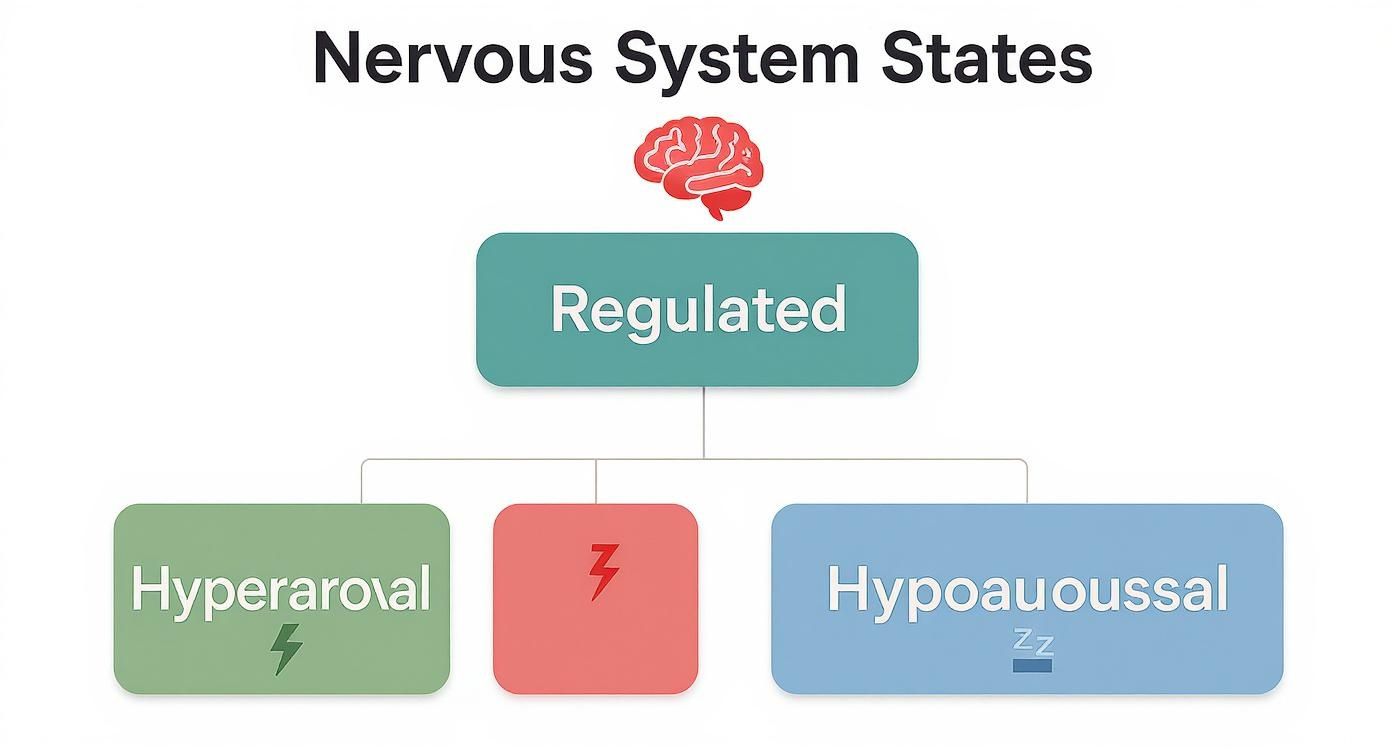Effective dysregulated nervous system treatment starts with understanding what it feels like to be out of balance. At its core, this feeling is your body's alert system getting stuck—either on high alert or in a state of complete shutdown. This can make even simple daily tasks feel overwhelming. The good news is that restoring this balance is not only possible but essential for your long-term health.
What It Feels Like When Your Nervous System Is Dysregulated
Imagine your body has two pedals: a gas pedal for action and a brake pedal for rest. When your nervous system is healthy and regulated, you can smoothly switch between them. You hit the gas to handle challenges and press the brake to recover.
But with a dysregulated nervous system, those pedals get stuck.
You might feel like the gas pedal is floored, even when there’s no real threat in sight. This is the sympathetic state, or "fight-or-flight." Your body is constantly primed for danger that isn't actually there, leaving you feeling jumpy, anxious, and perpetually on edge.
Or, your system might slam on the brakes, throwing you into a parasympathetic state of shutdown, often called "freeze." This isn't the gentle, restorative rest you need—it's a deep state of exhaustion and disconnection. You might feel numb and lethargic, like you're moving through life in slow motion.
This visual breaks down these different states, showing the path from a balanced system to the extremes of hyperarousal and hypoarousal.

As the infographic shows, a regulated system exists in a state of calm and connection. But when dysregulation takes over, it can swing into two very different, exhausting states.
Living in Hyperarousal or Hypoarousal
Being stuck in these states day after day is confusing and draining. When you're in hyperarousal (the "gas pedal" state), you might experience:
- A constant sense of dread or anxiety.
- Feeling irritable and quick to anger.
- Racing thoughts you just can't turn off.
- Trouble sleeping, feeling "wired but tired."
When you're stuck in hypoarousal (the "brake pedal" state), the experience is the complete opposite. You might feel:
- Chronic fatigue and profoundly low energy.
- Disconnected from your own body and emotions.
- Persistent brain fog and trouble concentrating.
- A sense of hopelessness or depression.
To give you a clearer picture, here’s a quick comparison of the two states.
Hyperarousal vs Hypoarousal States
| Characteristic | Sympathetic State (Hyperarousal) | Parasympathetic State (Hypoarousal) |
|---|---|---|
| Dominant Feeling | Anxiety, Panic, Anger | Numbness, Emptiness, Disconnection |
| Energy Level | High, Restless, Agitated | Low, Exhausted, Lethargic |
| Mental State | Racing Thoughts, Hypervigilance | Brain Fog, Poor Concentration |
| Physical Sensations | Pounding Heart, Tense Muscles | Heaviness, Slowed Breathing |
| Behavioral Response | Fight-or-Flight | Freeze, Shutdown |
Seeing these signs laid out can help you identify which state your body tends to get stuck in.
Understanding these feelings is the first real step toward finding the right dysregulated nervous system treatment. It's not a personal failing; it's a physiological response to stress that has built up over time. Recognizing your own patterns provides clarity and a path forward. For a deeper look into the mechanics, check out our guide on nervous system dysregulation.
The challenge of nervous system dysregulation is a global one. In 2021, over 3 billion people were living with neurological conditions, making these disorders the leading cause of illness worldwide.
This isn't just a small-scale problem. The global market for treatments is projected to hit USD 222.1 billion by 2035, which shows just how much people are searching for solutions that can restore balance and improve their quality of life. Realizing you're part of a much larger community facing similar struggles can be a powerful motivator to start your healing journey.
Recognizing the Common Signs of Dysregulation

A dysregulated nervous system isn't just a vague feeling of being "off." It shows up in very real, often confusing ways that can touch every single part of your life. Learning to spot these signs is the first, most important step toward finding an effective dysregulated nervous system treatment.
Why? Because it validates what you’re going through. What you're feeling is real, it has a name, and thankfully, it's something we can address.
These symptoms usually fall into three main buckets: physical, emotional, and cognitive. Think of each one as a clue from your body, telling you that its internal alarm system is stuck on high alert or, conversely, has gone into total shutdown mode.
Physical Symptoms That Signal Imbalance
Your body always keeps score. When your nervous system is stuck in a state of high alert or total exhaustion, it will inevitably start sending out physical distress signals. These aren’t just "in your head"—they are genuine physiological responses to that internal chaos.
You might notice nagging issues that doctors can't seem to pin down. For instance, many people with dysregulation deal with constant digestive upset, like indigestion or IBS-like symptoms, because the body’s "rest-and-digest" functions are constantly being sideswiped.
Other common physical red flags include:
- Chronic Fatigue: This isn't just being tired. It’s a deep, bone-deep exhaustion that sleep doesn’t fix. It feels like you're starting every single day on an empty tank.
- Persistent Muscle Tension: Are your shoulders always tight? Do you have a sore neck or a clenched jaw? That's a classic sign of a body physically holding onto stress.
- Frequent Headaches or Migraines: When you combine tension in the head and neck with a constant state of alert, you have a perfect recipe for chronic headaches.
- Sleep Disturbances: This often looks like being "wired but tired." You feel completely drained all day, but when your head hits the pillow, your brain won't shut off.
These physical symptoms are your nervous system’s way of waving a white flag and asking for support. They aren't signs of weakness but proof that your system has been working overtime for far too long. To find real relief, we have to get to the root cause.
Emotional and Cognitive Red Flags
Beyond the physical toll, dysregulation has a profound effect on your emotional world and mental clarity. It’s like trying to get through your day with an alarm blaring in the background—it’s agitating, distracting, and makes clear thinking feel next to impossible.
Emotionally, you might feel like you're on a rollercoaster you can’t get off of. One moment, you’re gripped by intense anxiety with a racing heart and a sense of doom. The next, you could feel completely numb and disconnected, which is a classic sign of the "freeze" or shutdown state.
Cognitively, the impact is just as severe. The term "brain fog" is the perfect way to describe the confusion and difficulty concentrating so many people experience. Your mind feels clouded, making decisions feel overwhelming and remembering simple things a real struggle.
Common Cognitive and Emotional Signs
- Heightened Anxiety or Hypervigilance: A constant feeling of being on edge, startled by small noises, or always scanning the room for potential threats.
- Irritability and Anger Outbursts: When your system is overloaded, your patience plummets. Minor frustrations can suddenly feel huge, leading to a short fuse and reactive anger.
- Feeling Numb or Disconnected: A sense of watching your life from a distance, detached from your own emotions or even your body.
- Trouble Concentrating: You can't focus on work, read a book, or even follow a conversation because your mind is either racing a million miles an hour or feels completely blank.
- Overwhelm: Simple, everyday tasks start to feel monumental. This can lead to procrastination or a feeling of being completely swamped by your to-do list.
If you’re nodding along as you read these lists, it’s a strong signal that your nervous system is crying out for help. The good news is that connecting these seemingly random symptoms to the single root cause of dysregulation is incredibly empowering. It allows you to seek targeted, effective care that goes way beyond just chasing individual symptoms.
Understanding the Root Causes of a Dysregulated System

A dysregulated nervous system doesn't just appear out of nowhere. It’s a state your body arrives at slowly, as its natural ability to manage stress gets worn down over time. Getting to the root of what’s happening is the first real step toward finding a lasting dysregulated nervous system treatment. It helps us shift the question from "what's wrong with me?" to a much more compassionate and productive one: "what happened to me?"
Think of your nervous system's capacity to handle stress as a bucket. Every single stressor you face—whether it's a big life event or a small daily annoyance—adds a little bit of water to that bucket. A healthy, regulated system has built-in drains, like getting good sleep or laughing with a friend, that let the water out.
But what happens when the stressors pour in faster than you can drain them? The bucket starts to overflow. That overflow is dysregulation. It's not a character flaw or a personal failing; it’s a completely logical physiological response to being overwhelmed for far too long.
The Slow Drip of Chronic Stress
For most people, the biggest culprit is chronic stress. We're not talking about a single, dramatic event, but the quiet, relentless pressure of modern life. It's the slow, steady drip that eventually fills your stress bucket right to the brim.
These everyday stressors often include:
- Work Pressure: The constant grind of tight deadlines, a difficult boss, or just a toxic environment you have to walk into day after day.
- Relationship Strain: Ongoing conflict with a partner, family member, or friend that keeps you feeling consistently on edge.
- Financial Worries: The low-level anxiety that hums in the background about paying bills, managing debt, or just feeling insecure about the future.
Each one of these sends a little "threat" signal to your nervous system. When those signals never stop, your body forgets how to turn off the alarm. It gets stuck in a state of permanent hypervigilance or, eventually, total exhaustion.
The Impact of Unresolved Trauma
Trauma is another massive piece of the puzzle, and it’s not always what people imagine. Of course, a single, major event (what some call "Big T" trauma) like a car accident or a profound loss can absolutely overwhelm the nervous system. But smaller, repeated stressors can be just as damaging.
"Little t" traumas are those subtle, often-dismissed experiences that slowly chip away at your sense of safety. This could be anything from childhood emotional neglect and persistent criticism to growing up in a home where your needs were consistently ignored.
These smaller wounds teach your nervous system that the world is fundamentally unsafe. Your body learns to stay on high alert simply to survive. Without a way to process and release that stored traumatic energy, the system remains locked in dysregulation long after the events are over.
Lifestyle Factors That Fill the Bucket
Finally, our daily choices play a huge role. Things like poor sleep, a diet heavy on processed foods, and not moving our bodies enough don't just affect our physical health—they directly impact our nervous system's ability to regulate itself.
Poor sleep, for instance, robs your brain of its nightly opportunity to repair and reset. Likewise, nutrient-poor foods can fuel inflammation, adding yet another layer of stress to your system. These factors act like open faucets, constantly pouring more water into an already full stress bucket and making it nearly impossible for your nervous system to find its way back to balance.
Exploring Effective Treatment Pathways
Finding the right dysregulated nervous system treatment is a deeply personal journey. There’s no one-size-fits-all answer, because the path back to balance looks different for everyone. Since dysregulation is really the body’s learned response to stress and threat, effective healing is all about teaching it how to feel safe again.
This usually means bringing together a combination of approaches that calm the "fight-or-flight" response and gently re-engage the "rest-and-digest" system. The goal isn’t to find a single magic bullet. It’s to build a toolkit of practices that support your system from multiple angles.
Think of it like learning a new language. You wouldn't just study vocabulary; you’d also practice pronunciation, grammar, and conversation. In the same way, healing your nervous system means addressing your mind, body, and daily habits all at once.
This body-first approach is gaining serious momentum. The global market for somatic therapies and nervous system regulation is projected to hit USD 12.40 billion by 2032, growing at a remarkable 17.5% each year. This boom reflects a widespread understanding that we have to include the body to get to the root of anxiety, trauma, and chronic stress. You can find more details on this trend over at the integratedhealthfoundation.org website.
Somatic and Body-Based Therapies
Somatic therapies are built on a simple yet profound principle: the body keeps the score. These methods focus on releasing the stress and trauma that get physically stuck inside us, rather than just talking it through. By tuning into what your body is telling you, you can finally help your nervous system complete stress cycles that have been on a loop for years.
Some of the most effective somatic approaches include:
- Somatic Experiencing (SE): This is a gentle therapy that helps you become aware of the physical sensations tied to your stress and trauma. A practitioner guides you to safely process these feelings in small, manageable doses, which keeps you from getting overwhelmed and helps your system rediscover a state of calm.
- Eye Movement Desensitization and Reprocessing (EMDR): Often used for PTSD, EMDR uses bilateral stimulation—like guided eye movements—to help the brain reprocess traumatic memories. This allows the nervous system to file those old experiences away properly, so they stop triggering a constant state of alarm.
- Yoga and Mindful Movement: Practices like yoga, tai chi, or even just gentle dancing build a powerful mind-body connection. They combine physical postures, breathing, and meditation to release muscle tension, lower cortisol levels, and activate the calming parasympathetic nervous system.
Somatic work is about listening to the quiet wisdom of your body. It teaches you that sensations of tightness, shaking, or heat are not just symptoms to be ignored but messages from a nervous system trying to heal itself.
Mindfulness and Breathwork Techniques
While somatic therapies work from the body up, mindfulness and breathwork help regulate the system from the top down. These practices train your brain to stay in the present moment and calm the physical stress response through conscious control.
Mindfulness meditation teaches you to simply observe your thoughts and feelings without judgment. This can be a game-changer for interrupting anxious thought spirals, strengthening your ability to respond to situations calmly instead of reacting out of fear.
Breathwork is one of the fastest and most direct ways to influence your nervous system. Seriously.
- Deep Belly Breathing: When you inhale so deeply that your belly expands, you activate the vagus nerve—a key player in your parasympathetic "rest-and-digest" system.
- Box Breathing: Inhale for four counts, hold for four, exhale for four, and hold again for four. This predictable rhythm is a powerful signal of safety to your brain.
- Extended Exhales: Simply making your exhale longer than your inhale slows your heart rate and tells your body it’s time to relax.
Working these simple practices into your daily routine can make a huge difference. For a deeper dive into how these techniques work, our guide on how to repair your autonomic nervous system offers some great insights. These strategies build a strong foundation for recovery, preparing your system for the more targeted interventions that can address the deep-seated neurological patterns of dysregulation.
How Neuro-Tonal Chiropractic Care Restores Balance
Things like breathwork and somatic therapies are fantastic tools for managing the symptoms of a dysregulated nervous system. They’re excellent for calming your body’s response to stress. But what if you could get to the physical source of the stress signals themselves? This is where a specialized, neurologically-focused approach offers a unique path for dysregulated nervous system treatment.
Unlike traditional chiropractic that often focuses on pain and mobility, neuro-tonal chiropractic zeroes in on the most critical communication hub in your body: the upper spine and brainstem. You can think of this area as the main server room for your entire nervous system. It’s the spot where your brain sends and receives every single signal controlling your mood, energy, sleep, and stress response.
When this area is even slightly out of alignment, it’s like having static on the line. The vital messages between your brainstem, the crucial vagus nerve, and the rest of your body get weak, distorted, or completely scrambled. Your body simply can't interpret signals of safety correctly, leaving it stuck in a state of high alert or shutdown.
Targeting the Source of the Signals
The main goal of neuro-tonal chiropractic is to clear up that static. The focus isn't on forceful adjustments but on gentle, precise corrections that restore proper alignment and, most importantly, the right "tone" to the nervous system.
Imagine a sensitive dimmer switch for a light bulb. If the switch is faulty, the light will flicker, stay too bright, or won't turn on at all. Neuro-tonal care is like a skilled electrician carefully repairing that switch, allowing the flow of energy to become smooth and consistent again. It’s a targeted fix aimed directly at the system’s control panel.
At First Steps Chiropractic, this isn't guesswork. We use advanced diagnostic tools like INSiGHT scans to get a clear, data-driven picture of where your nervous system is struggling. These scans measure nerve activity and stress patterns, showing us precisely where the interference is happening.
This allows us to create a highly specific and customized care plan. We can see exactly how your system is functioning—or malfunctioning—and tailor adjustments to restore clear communication right where it’s needed most.
The Gentle Path to Re-Regulation
The adjustments themselves are incredibly gentle. You won’t experience any popping, cracking, or twisting. Instead, we use techniques like the Torque Release Technique (TRT), which applies precise, light-force adjustments to influence the nervous system and release stored tension. It's a subtle approach, but it’s profoundly powerful.
Here’s how it helps restore balance:
- It Calms the Alarm System: Gentle adjustments to the upper spine directly influence the brainstem, which helps dial down the sympathetic "fight-or-flight" response that keeps you feeling anxious and on edge.
- It Activates the Vagus Nerve: By improving the alignment and function of the upper neck, this technique helps stimulate the vagus nerve. This is the main highway of your parasympathetic "rest-and-digest" system, which is key to promoting feelings of calm and safety.
- It Restores Proper Signaling: Correcting these tiny misalignments, or subluxations, removes the physical interference that’s disrupting nerve flow. This allows your brain and body to finally communicate clearly again, improving everything from sleep cycles to emotional regulation.
This method does more than just manage symptoms; it gets to the root of the neurological patterns that keep your system dysregulated. By correcting the physical source of the imbalance, it creates a solid foundation for lasting change. Our detailed guide on functional neurology chiropractic explains more about how these targeted adjustments can retrain the brain and nervous system over time, building new pathways toward resilience and well-being.
Mapping Your Journey to a Regulated State

Starting a dysregulated nervous system treatment plan is a lot like planting a garden. You won't see everything bloom overnight, but if you tend to it consistently, incredible growth is just around the corner. Healing is a process of retraining your body and brain, not a quick fix, so understanding the timeline helps you stay committed and celebrate the small wins.
The magic behind this process is neuroplasticity—your brain's amazing ability to rewire itself. Think of it like building muscle at the gym; with consistent practice, you’re forging new neural pathways that teach your body how to find calm and safety. The journey isn’t always a straight line. You'll have good days and tough ones, but every single step contributes to lasting change.
Key Milestones on Your Path to Regulation
It helps to have a roadmap. While everyone's path is unique, research gives us some solid benchmarks for what to expect. Many people start noticing initial improvements, like better sleep or feeling a little less reactive, within the first 1-2 months.
By the 4-6 month mark, those new, calmer neural pathways are becoming more established, leading to real, measurable progress in your body’s autonomic regulation. You can get into the science behind typical recovery timelines in this study.
This process truly requires patience. Most people see a substantial drop in their symptoms and feel more resilient within 8-12 months of consistent care. For those navigating chronic conditions or significant trauma, finding that optimal state can take 1-2 years of dedicated work.
When you view your progress through these milestones, you can start to appreciate the deep, foundational healing your body is doing. Each phase marks a huge shift in how your nervous system sees and responds to the world around you.
Recovery Milestones and Expected Timelines
To give you a clearer picture of this journey, we’ve put together a table outlining what you might experience at different stages of your care with us.
| Milestone | Typical Timeline | What You Might Experience |
|---|---|---|
| Initial Shifts | 1–3 Months | Better sleep quality, fewer digestive issues, moments of calm, and a slight reduction in anxiety. |
| Building Momentum | 4–7 Months | More consistent emotional stability, increased capacity to handle daily stressors without overwhelm, and less brain fog. |
| Deep Integration | 8–12+ Months | A new baseline of calm and safety, stronger resilience to triggers, and a deeper connection to your body and emotions. |
Remember, this timeline isn't a strict deadline but a hopeful guide. Consistency is your most powerful tool, turning small, daily actions into a whole new, regulated way of being.
Frequently Asked Questions
Navigating the path to a regulated nervous system naturally brings up a lot of questions. We get it. Below, we’ve answered some of the most common ones we hear from families, giving you clear, straightforward information to help you feel confident about the journey ahead.
This section is all about getting to the heart of your concerns and explaining what a neurologically-focused approach to a dysregulated nervous system really looks like.
How Do I Know If My Nervous System Is Dysregulated?
Recognizing the signs is the first, most important step. Think of it like this: does your anxiety feel like an engine that’s always running? Do you feel a deep, persistent fatigue that a full night's sleep just doesn't touch? Or maybe you're dealing with digestive issues that have no clear medical cause. These are classic signs.
You might also feel a constant brain fog that makes it hard to focus, or you might find yourself feeling overwhelmed, irritable, or even numb and disconnected. If you feel "stuck" in a high-alert state (fight-or-flight) or a shutdown, withdrawn state (freeze), that’s a powerful indicator that your nervous system is calling out for support.
Is Neuro Tonal Chiropractic Care Safe and Gentle?
Yes, absolutely. This specialized approach is one of the safest and most gentle forms of chiropractic care out there. We specifically avoid any of the traditional popping, cracking, or twisting of the neck or spine that many people associate with chiropractic.
Our techniques, like the Torque Release Technique (TRT), are designed to be incredibly precise and use a very light force. The entire goal is to communicate with the nervous system right at its source without causing any discomfort. This makes it a comfortable and effective treatment for everyone, from tiny newborns to adults.
This gentle method is all about restoring balance by getting to the root of the interference.
How Long Does It Take to Feel Better?
Everyone’s healing journey is different, but many of our patients start noticing the first positive shifts within one to two months of consistent care. These initial changes often show up in the areas your autonomic nervous system controls without you even thinking about it.
For instance, you might suddenly realize you’re sleeping more deeply, your digestion feels calmer, or that baseline hum of anxiety has finally quieted down. These are the first green shoots—signs that your body is learning and adapting to a new, more regulated pattern.
Lasting, significant change typically builds over 8-12 months of consistent care. During this time, your nervous system isn’t just getting temporary relief; it’s actually building new, healthier neural pathways. This creates a strong foundation of resilience and well-being that becomes your new normal.
At First Steps Chiropractic, we’re dedicated to helping you restore that balance and reclaim your health through specialized, neurologically-focused care. If you're ready to start your journey toward a regulated nervous system, schedule your complimentary consultation with us today.

